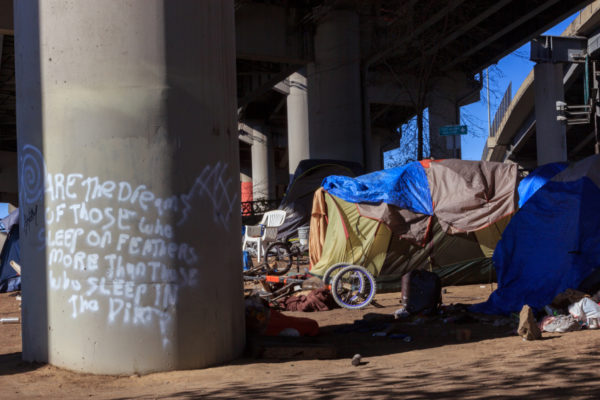Texas Gov. Greg Abbott recently wrote a letter requesting that Austin Mayor Steve Adler improve the homeless situation by Nov. 1, or the governor will direct every applicable state agency to act to fulfill his responsibility to protect the health and safety of Texans in the Austin jurisdiction. In a tweet, Abbott also encouraged Austin residents to share photos and videos of the city’s homeless on social media to bring attention to safety concerns.
This approach not only promotes an “us versus them” mentality but also fails to do justice to the long history of homelessness in Austin and the complex personal histories that keep people on the streets.
In June, the Austin City Council amended existing ordinances to decriminalize homelessness, allowing homeless people to camp or lie down on city streets as long as they don’t pose a public health or safety hazard. Since then, some have gotten the impression that there has been a sudden increase in the homeless population in Austin.
The reality is that between 2018 and 2019, the city’s homeless population grew by only approximately 5%. What has changed since the ordinances went into effect is the increased visibility of homeless individuals who were already camping within the city or county limits.
The ordinance making camping illegal in the city went into effect in 1996. Since then, the city has continued to try and address a homeless problem that was worsened, rather than improved, by outlawing camping. People experiencing homelessness kept switching locations after receiving tickets from the Austin police, and in many cases, camping citations placed additional hurdles when individuals tried to qualify for already scarce housing resources.
The June amendments eliminated some barriers on the way out of homelessness. Fewer restrictions on camping locations means more consistent access to resources and jobs. It also means camping in areas less hidden from law enforcement, and thus safer nights. Not being ticketed or arrested for camping means fewer complicating legal issues when applying for jobs or housing resources.
The City of Austin is now challenged with how to fully address the complex problem of homelessness. And temporary shelters will not solve the problem.
In recent years, Austin has seen a significant rise in the rate of people who are chronically homeless (individuals who lack permanent shelter for more than a year) within the homeless population — from 22% in 2015 to 54% in 2018. People experiencing chronic homelessness probably are facing other challenges such as mental health problems, disabilities, substance abuse issues, histories of trauma, and legal issues.
Chronic homelessness can be ended, as shown by several communities across the country. Other communities have made great inroads ending homelessness for veteran residents. To get there, Austin needs to look at broader interventions to end chronic homelessness, and Gov. Abbott needs to let the city exercise its autonomy or, even better, support the city’s decisions with state resources.
The resources Abbott has vowed to send to Austin to protect the health and safety of city residents could much better be used to assist in implementing long-term fixes for homelessness, such as establishing a continuum of housing options.
According to the United States Interagency Council on Homelessness, interventions to end chronic homelessness should start at the top of the state leadership and should involve a public commitment to resources for supportive housing and other services. Examples from across the globe show that a housing-first model ensures that homeless people enter housing as quickly as possible, lowering the risk for chronic homelessness.
We must understand that pushing homeless people back into the shadows won’t solve anything. We all share the common goal of wanting homeless people off the streets. We all need to dig deep and take this opportunity to see people who are homeless in our city in all their complexities and humanity. Ending chronic homelessness in Austin is within our reach if we commit to it.
Cossy Hough is a clinical associate professor in the Steve Hicks School of Social Work at The University of Texas at Austin. She also serves as a board member for the Ending Community Homelessness Coalition (ECHO) in Austin.
A version of this op-ed appeared in the Austin American Statesman.




